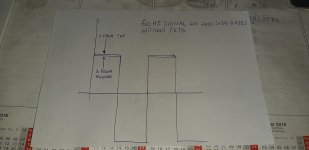Hello to all the members.
I have a question.
I'm repairing an EMPHASER EA15000SPL (output mosfet and short ICs).
I replaced all the IRS21844S, but unfortunately I had 3 IRS21844S coming from Mouser and 1 IRS21844S coming from TME, all 4 chips are original and perfect, in fact I ran all the tests, and the signals are all ok, but I noticed that the 3 Mouser's IRS have a slightly lower output than TME's IRS (they all work perfectly even when installing mosfets).
I noticed this small difference only by looking at the waveform on the oscilloscope on the low side gates before install the fets.
I will make a small example by drawing by hand.
Have any of you ever used IRS chips of different suppliers?
I can assure you that all IRSs are original, even if they come from different suppliers.
I have a question.
I'm repairing an EMPHASER EA15000SPL (output mosfet and short ICs).
I replaced all the IRS21844S, but unfortunately I had 3 IRS21844S coming from Mouser and 1 IRS21844S coming from TME, all 4 chips are original and perfect, in fact I ran all the tests, and the signals are all ok, but I noticed that the 3 Mouser's IRS have a slightly lower output than TME's IRS (they all work perfectly even when installing mosfets).
I noticed this small difference only by looking at the waveform on the oscilloscope on the low side gates before install the fets.
I will make a small example by drawing by hand.
Have any of you ever used IRS chips of different suppliers?
I can assure you that all IRSs are original, even if they come from different suppliers.
Attachments
Ive always matched mine with the same date code in the amplifiers just to be safe. Then again Ive had atleast one fet from each driver blow usually.
If I were you I would find an identical amp and test that driver board in that amp to see if the results are the same.
Maybe something to do with the date code, shelf time, or humidity of the IRS21844S?
I am curious as well now.
If I were you I would find an identical amp and test that driver board in that amp to see if the results are the same.
Maybe something to do with the date code, shelf time, or humidity of the IRS21844S?
I am curious as well now.
Natural tolerances come to mind. As long as the voltage increases far enough to switch the gate of the FET on and off, there is no issue. The data sheet allows for a 0.6volt leeway on the output voltage; https://www.infineon.com/dgdl/Infin...N.pdf?fileId=5546d462533600a401535676d8da27db
Actually I also installed the mosfets (only 2 per branch for each amplifier) using some test IRFP360LCs.Would you be concerned about the Mouser ICs if you would not have seen the waveforms from the other IC?
Do all of the ICs have the exact same supply voltage (measured directly across VCC and COM very near the IC (don't slip if measuring on the IC pins).
The amplifier worked well, the switching frequency was good (130khz, variable depending on the battery voltage) identical for all 4 amplifiers.
Then I removed the test mosfets to proceed with the installation of 16 new FDA24N40Fs, but first, I wanted to do a double test, so I got to where I am now.
Anyway, I installed the new mosfets, and the amp works flawlessly, so I assume there are no problems with that small difference in amplitude.
To answer your question, if I hadn't noticed this, I probably would have installed the mosfets directly, but it was good to see it, you know better than anyone else that these amplifiers are real nightmares even for a little nonsense.
- Status
- This old topic is closed. If you want to reopen this topic, contact a moderator using the "Report Post" button.
